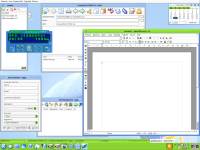Installing Linux with Windows

Installing Linux with Windows is not always safe. This is evidenced, for example, by the installation of Mandriva. It looks like the system is installed on a removable unit connected to the USB port without any visible problems. But in the process, the GRUBE boot program becomes authoritative on the hard drive, without warning or choice left to the user. It replaces the Vista primer and doesn't even work, leaving you with two unusable systems. Fortunately, repair software is also supplied with the computer.
Installing the operating system on drive A and the boot drive on drive B is logical, especially if drive A is removable and does not have to be there when starting the computer!
This article provides a general description of installing a Linux distribution with Windows. The choice of distribution is up to the user. The most famous are Suse, Fedora, Debian, Ubuntu, Mandriva, Knoppix or Kaella in the French version.
Preliminary requirement
The installation disc or ISO image to burn. With distributions like Suse, you can install from Windows.
To settle
Always choosing "expert mode" or "advanced" is not more technical, and this opens up irreplaceable options.
- It is better to install Linux on a second disk. Otherwise, you can share the Windows partition.
- If you have an accessible and free section, ignore this section, go to 2)
- Use SCANDISK (System Tools) to fix hard disk errors.
- Use DEFRAG to prepare for partitioning using the free space block.
Note that there is free disk space.
Vista allows you to resize the main partition to create another partition next to it that can be used for Linux.
You can also choose to install on a USB drive. First, make sure the boot system is installed on the same drive, not on a Vista drive! - Insert the disc into the drive.
Restart the computer, press DEL or F1, or press the key that opens the Bios setup panel, and adjust the Bios settings to boot the computer to the CD. Save and continue the download process. Then you need to run from the Linux CD. Select an expert. - You are asked to choose between expert mode or not. The second will install Lilo or Grub without asking for your opinion. When installing Lilo, you will need to choose between Windows and Linux every time you start your computer. So choose an expert.
- Select keyboard, language, etc.
In the partition option, if you do not have a second disk or free partition, click the current partition and select resize.
Do not use all the free space, keep stock for Windows.
Create a swap partition according to the table below.
Linux requires at least 2 gigs to install. Linux reads the Windows FAT and NTFS directories (2.6 kernel), no need to create too large a partition. - Click on the partition scheduled for exchange, do SWAP and install there (MOUNT).
Click another new section. Do Linux, do it.
The recommended file system is ext3. - Continue with the graphical installer.
You may be asked to install Lilo or Grube, bootloader, choose Grub. - Continue with other options.
- To run on a USB drive, restart your computer and go to Bios. Select the USB drive as the first boot device.
- Modify environment variables and environments as needed, see below.
|
Swap Partition Size
|
|
|
List
|
Swap
|
|
256
|
512
|
|
512
|
1024
|
|
1024
|
1592
|
|
2048
|
2048
|
Equipment
To install the rpm package, just click on it from the file manager. Mandriva, Suze, Fedora use this format.
Kaella and Debian use apt packages for the applications you want to add.
To install the apt package, just click on it from the file manager.
You can also use a synaptic program taken from the menu.
To install the .tar.gz archive:
- Start the session as root or open the superuser device by typing su.
- Copy the archive to the/usr/local directory.
- Enter: tar -zxvf nomarchive.
- Go to the newly created directory.
- Depending on what is said in the INSTALL text file, you may need to enter commands such as: ./setup, make, etc.
- You may need to add a program to the path. Edit the/etc/profile file, add the path of the executable file (without the file name) to the PATH variable, separated by the ":" character.
- Close the session and restart as a normal user before using the program.
Edit .bashrc
To change fast to something decent, get access to programs, especially in the current directory...
Here is an example for the user/home/user directory, add these lines...
PATH=/bin:/sbin:/usr/bin:/usr/sbin:/usr/X11R6/bin:/usr/local/bin:.:/home/user PS1="\w>" PRINTER=epson/55 export JAVA_HOME=~/jdk1.5 alias cprinter=/usr/local/epson/55/bin/lsc export cprinter
Before purchasing equipment
Before buying a device, do not limit yourself to the list on the Linux distribution website. Browse sites such as Linux Compatible and fully read FAQs and forums.
Further information
- Linux issues. Answers to your questions.
- File system comparison. Choice between ext3, ReiserFS, etc. (English).
- Windows applications running Linux with Wine.
Downloads
On this site you can find rpm Mandriva/Suse/Fedora: Rpm Find.
On this site you can find the debian application: Debian.